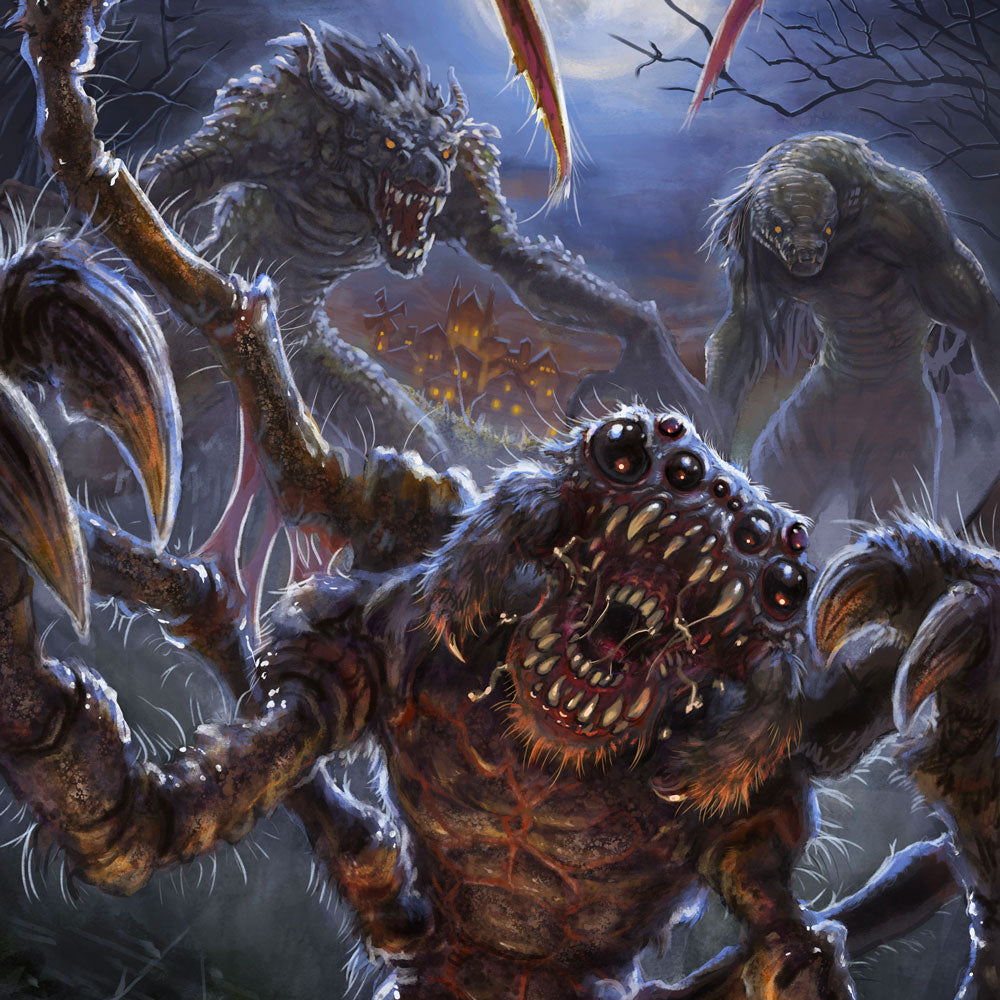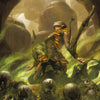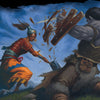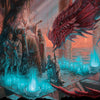How to Play as a Lycanthrope in D&D

If you’re a player, having your character become a lycanthrope—a werewolf, werebear, weretiger, or the like—can be an exhilarating part of your tabletop RPG experience. And if you’re a game master, the prospect of PCs running around as lycanthropes…could be terrifying.
So, today we’re talking about two mistakes we often make when using lycanthropy in our games. And we’re going to discuss HOW we might implement lycanthropy so that both PLAYERS and GAME MASTERS enjoy the experience.
By the way, if you’d like to get several new werebeasts you can use in your 5e or Pathfinder 2e games—werespiders, weresnakes, and even weredragons!—take a look at Lair Magazine #34, Luna & Lycan. You’ll also get two mini-adventures and two full-length adventures featuring lycanthropes!
Watch or listen to this article by clicking the video below.
Mistake #1: We Screw Up Lycanthropes as Playable Races
Players love the idea of playing a lycanthrope as it represents power and a cool roleplaying opportunity. However, the GM has a conundrum. Giving the power of lycanthropy to one character can breed jealousy and is not fair to other players. It also creates unbalance in the game. How do you adjust for a PC with super powers?
Some GMs may not care about all this and just give it out willy nilly; that’s fine if that’s your style. I guess, though I could enumerate lots of reasons that could cause problems.
Of course, some systems have a different solution to the issue. In Pathfinder 2e, for instance, if a PC becomes a lycanthrope, they revert to the control of the GM.
So, we have two extremes, neither of which is very satisfying: overwhelming power and chaos or the loss of a PC. Surely there is a middle ground? A way that allows us to play as lycanthropes without breaking the game or losing our characters?
How Should Lycanthropy Be Used Then?
One method is to treat lycanthropy as an AFFLICTION, which of course is how it’s usually portrayed in literature and movies.
You see, this is the idea that most people have in mind when they hear someone is a lycanthrope: a powerful, dangerous affliction that warps the mind and body into something far more sinister than their true form. The challenge with making it an affliction is ensuring the player retains agency over their character. Our solution is to turn it into a progressive matter that ebbs and flows with the moon and allows the player to explore a new aspect of roleplaying their character. The critical component of this type of lycanthropy is that the character cannot control their transformation.
Not all lycanthropy must be transmitted via a bite, though that is by far the most common. But when a character is bitten (or scratched, or any other option being used) and becomes afflicted, things begin to change for that character. There should always be a period between when the bite happens and when symptoms start to appear. During this period, the character shouldn’t exhibit any symptoms indicating they might have contracted the affliction.
The trick here is to NOT tell the player! The GM should keep track of this as it avoids metagaming. This is a good reason to have other ways of being afflicted besides just BITES. And if the PC is bitten and has to roll a saving throw, ROLL IT YOURSELF, BEHIND THE SCREEN.
To play up the mystery and horror of the moment, you must avoid letting the player know if they were afflicted or not. Eventually, they will forget all about the event, and then several sessions later when you reveal that they have lycanthropy, it will be a fun surprise and an awesome moment.
The Three Stages of Lycanthropy
Once afflicted, there are three stages the characters goes through.
Stage One. In this early stage, little changes for the character. They don’t gain any of the special benefits of being a lycanthrope, nor do they have any serious drawbacks. Instead, they simply begin taking on a different mentality; perhaps it’s described as a hunter or bestial mentality. Regardless, it’s a subtle shift; you can work with the player to describe it, and it does not shift their alignment. This is a pure roleplaying opportunity for your player. This stage is where all new lycanthropes should start and where they return after each transformation.
Stage Two. This is where things become noticeable. This stage begins about 2/3 of the way to a forced transformation. If a forced transformation occurs during a full moon, for example, this stage will begin around 10 days before that. During this stage, the character’s bestial mentality is intensified by at least double – make sure you ask them to roleplay that at the table. Their skin and face begin to vaguely resemble the creature they will become, but not to the extent that it becomes obvious they’re something other than a typical person. At this stage, they gain the resistances, immunities, and vulnerabilities associated with their type of lycanthropy.
Note: I would not give IMMUNITY to non-silver weapons myself. That would make them immune to the damage from most creatures in the world and is WAY TOO MUCH. I personally would give them RESISTANCE to damage from non-silver weapons. It’s much more reasonable.
Stage Three. This is the ultimate stage of the affliction where the character forcibly transforms into their bestial form, and it probably only lasts for a few days while the moon is full.
If the system you’re running allows the character to be conscious during this transformation—such as D&D 5e—they should experience an alignment shift towards whatever brand of evil is associated with their type of lycanthrope. They can then roleplay this as they feel is appropriate based on their circumstances.
On the other hand, if the system renders the character unconscious during the transformation—such as Pathfinder 2e—it should be handled like downtime. Work with the player to decide what actions their character would have taken and use the dice to resolve it. At this stage, the character would gain all the benefits of their lycanthropic stat block.
Other Lycanthropy Considerations
The Cycle. So, lycanthropes move between stages one and three based on whatever cycle your system uses, typically the moon. After they leave stage three, they revert to stage one, and the cycle begins again. However, to add greater stakes, once they reach stage three for the first time, they can try resisting their urges. If the character attempts to do this, they should roll either a Wisdom saving throw or a Will save, depending on the system. On a successful roll, they can resist the urge to kill, though they still experience a mental shift. If they fail, they cannot resist the urge to kill, though their targets are still up to them.
The Cure and the Fall. In this system, being cured requires a character to resist their urge to kill in their transformed state. If they manage this and keep themselves in their right senses, they can seek a cure. The cure should be more challenging to find than simply casting a spell; instead, it should involve some form of quest to locate it. However, should they fail to resist their urges—even once—and kill in their transformed state, their lycanthropy becomes permanent, and only the most powerful magic can remove it. They also fall from whatever grace they may have once had and permanently become evil.
Permanent Lycanthropy. Now, if I had a player whose character became a PERMANENT lycanthrope, this is what I would personally do if I wanted them to actually experience the powers and benefits of lycanthropy: I would make lycanthropy a CLASS that they can choose to multi-class into – or if you’re playing Pathfinder 2, it would be an archetype that the character can take, along with archetype feats.
So, let’s say you have a level 5 wizard that gets bitten and becomes a weretiger. Well, the first time they go through the cycle we described above, they get to experience the FULL BENEFITS of the weretiger. I would give the player a taste of how awesome it could be to be a weretiger wizard. And then, once the cycle begins anew and they loose their weretiger powers, I would tell the player that if they wish to continue down the road of being a weretiger they need to MASTER their own lycanthropic urges. And that means spending time focused on doing so; otherwise, they would lose total control of themselves.
So, if they want to master this lycanthropic side of themselves, I would make weretiger a class that they could multi-class into. I would either design the class myself or go out on the internet and see if someone has already done that for me – and I bet someone has, LOL. And then at each level up, the player can choose to EITHER take a level in wizard OR a level in weretiger. As they level up in weretiger, they would naturally unlock more and more benefits and powers as a weretiger.
The benefits of this approach are:
- First, it maintains balance in the game. Lycanthropy power replaces class power; in this case the character has weretiger powers instead of wizard powers.
- Second, it allows player agency. They get to choose what to do: weretiger or wizard at every level.
Essentially, it avoids most of the pitfalls and provides most of the benefits of lycanthropy in player characters. It’s a perfect solution, in my opinion.
Mistake #2: We Screw Up Lycanthropes as Villains
If we cast our gaze to literature or movies, we see lycanthropes playing out their parts in mysterious and horrific ways.
A lone lycanthrope taking out victims in back allies with the local populace horrified that a killer is on the lose. No one wants to go out at night. Perhaps even the day isn’t safe? And the killer, the lycanthrope, can walk among them during the day, blending in perfectly, sowing gossip and fear all the while picking out their next victim.
Or a gang of lycanthropes, wererats let’s say, running wild in the sewers. During the day, they are reputable members of society – a baker, a butcher, a blacksmith – but at night they run the local thieves guild, and even perform the occasional murder for hire.
Or perhaps lycanthropy is an affliction, a pandemic, that is spreading through the city, consuming person after person, and eventually the scales will shift so much that the city guard won’t be able to hold the tide back, no matter how many werewolves they slay.
However, instead of that, how do we often portray lycanthropes in our tabletop roleplaying games?
Well, if we look to a classic module, Curse of Strahd, and specifically the 5e version, we find a gang of werewolves just sort of hanging out in a cave out in the middle of nowhere. What are they doing? Not a whole lot. Oh, occasionally they are random encounters that the characters stumble across – lumberjacks or the sort, perhaps looking to rough them up, perhaps demanding the characters relinquish all their silver.
But are the werewolves infiltrating the local town, Krezk? Do they serve as an active plot element in the region? Naw, they just sit in their den, waiting for the characters to come slaughter them. Seems rather bland, like a missed opportunity, doesn’t it? Okay, sure the people of Krezk stay walled in their town for fear of the werewolves, but surely werewolves could be put to better use than just prowling the woods and keeping terrified villagers walled up in their town.
So, what I’m suggesting is that instead when we, as game masters, employ lycanthropes or lycanthropy in our games, we consider using them as one of the three methods I hit on previously: as a lone wolf, as a pack, or as an epidemic.
Now, exactly how you chose to implement those in your games and how you structure your adventures is, well, up to you. However, to help you along that road, I’m going to delve a bit more into what each of these means and entails.
The Lone Wolf
Lone wolves are, by definition, loners. They operate alone, often attacking and killing seemingly at random. At first, their attacks may be considered the actions of a wild animal or rabid dog rather than the far more sinister truth. In fact, lone wolves will often be fully integrated into society as known citizens—though some behaviors might mark them as out of the ordinary.
The starting point to create a lone wolf as an antagonist is to consider their duality. More than as a pack or epidemic, a lone wolf is usually defined by their dual nature as beast and man. Where did this duality come from? Were they born into it, cursed from the moment they were born? If that’s the case, they may seek revenge against the world for their affliction. They may even seek political or military power to further their goals in both their forms.
Of course, not all lycanthropes are born that way—in fact, few typically are. More commonly, the person will have been inflicted with lycanthropy, usually unwillingly. If this is the case, it is vital to ask whether they are conscious of their transformations. Those aware of their lycanthropy will often fall into the same tropes as those born as lycanthropes. Those unaware of it will be more complex; they serve as an antagonist found on the street, walking right next to you—until the sun sets.
It is the duality of their being that defines the lone wolf archetype. They may socially withdraw, hidden away from society lest anyone discovers their secret; they know their survival depends on secrecy, for they are only truly powerful in their lycanthrope form. On the other hand, others will intermingle, taking to the saying, “Keep your enemies close.”
The Pack
A pack of lycanthropes is the next tier above the lone wolf. These groups hunt and live together, often in the wilderness but sometimes within a city. The most common way a pack starts is when a lone wolf embraces their affliction and begins to turn others into werewolves. This lone wolf then becomes the leader of the pack, often referred to as the “alpha.”
This is where the formation of a lycanthrope pack begins. It’s not something that remains static and unchanging. Instead, it evolves over time. The pack creates new members when needed, the group dynamics may shift, and a subset may break off to form another pack; the options are fairly endless. Each time the pack encounters an obstacle, trial, or other adversity, it will change in some fashion. The size of these changes corresponds to the size of the adversity; something minor will only have minor changes, while the death of a member may cause massive changes or even redefine the group.
This highlights the core idea of the pack: it is about the pack first and above all else. Unlike other villainous groups—such as vampires—a pack doesn’t usually serve an individual. The fact that there is a leader is only in furtherance of the pack itself rather than the other way around. Remembering this is critical to building an effective pack because it will influence the dynamics.
This isn’t to say that they operate with a selfless hive mind like an insect. Each pack member still has aspirations and goals independent from the rest. However, the pack, from its structure to its members, to the evolutions it will undergo, is for the furtherance of the pack. Each member benefits from this arrangement and can meet the goals they set for themselves in this way; after all, working together to achieve individual goals strengthens the individuals, which in turn strengthens the pack.
The Epidemic
Finally, we come to the largest and most severe situation: the epidemic—the lycanthrope affliction spreading without restriction. It’s rare and seldom seen, though it draws on some of the same ideas as a zombie apocalypse.
These typically begin when a pack’s existence is threatened, but not enough to wipe them out in one shot. Like bacteria that survive antibiotics, they evolve to resist the threat and begin to multiply out of control. They pass on to their progeny that they have to make more and more to further grow in number. Soon, they are threatening entire regions and nations with the curse.
How an epidemic behaves depends largely on the setting and nature of the affliction. If they can transform at will, it will quickly and aggressively spread with massive violence each day. It’s quite possible that the situation will demolish a nation or even form a nation of lycanthropes.
On the other hand, if the transformation is limited—such as only to the full moon—things will progress a little more slowly. It may not even be clear that an epidemic has been happening for some time since the transformations and victims only appear occasionally, and people blame the violence on other things such as a murderer.
New Lycanthropes for Your 5e or Pathfinder 2e Game!
Now, if you’d like to get a whole bunch of NEW WEREBEASTS you can use in your 5e or Pathfinder 2 games—werespiders, weresnakes, and even weredragons!—you should check out Lair Magazine #34, Luna & Lycan.
In addition to loads of new werecreatures, you’ll also get two level 5 and 6 mini-adventures, and two full-length adventures for levels 13 and 14 – all featuring lycanthropes as villains and antagonists. You’ll also get five encounters with lycanthropes.
Luna & Lycan is loaded with lycanthropes for your games!
And, of course, everything comes complete with the digital maps you’ll need to run these in the virtual tabletop of your choice. Unless, of course, you use Foundry VTT; because in that case, you can get Lair Magazine adventures as Foundry packs, 100% ready to plug and play.
-
Posted in
Game Master How-To Articles







